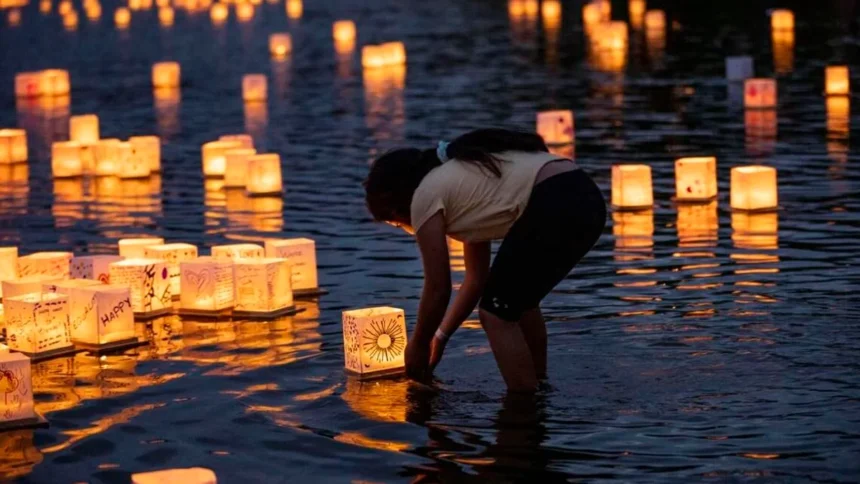Origins and Significance of the Water Lantern Festival
The Water Lantern Festival has a rich and diverse history that spans various cultures and traditions. This captivating event is rooted in ancient practices that revolved around the themes of light, hope, and remembrance. In many communities, these lanterns symbolize the release of worries and the welcoming of positivity as they are floated on water. The festival’s origins can be traced back to numerous traditions, including the Lantern Festival celebrated in China, which marks the end of the Lunar New Year festivities. During this celebration, participants would illuminate their hopes and dreams by releasing lanterns into the night sky.
Across different cultures, the water lantern serves as a powerful symbol of life and connection to the divine. In Japan, for instance, the Toro Nagashi festival commemorates ancestors by sending floating lanterns down rivers, guiding their spirits. Similarly, in Thailand, the Loi Krathong festival involves releasing decorated floats into the water, representing gratitude to the water spirits while seeking forgiveness for past wrongdoings. These practices highlight the spiritual dimensions of the Water Lantern Festival, reflecting a shared desire to celebrate life, honor the past, and seek blessings for the future.
The festival has evolved significantly over the years, adapting to contemporary values while maintaining its core beliefs. In recent times, it has gained global popularity, attracting participants from various backgrounds who gather to experience the magic of this enchanting event. The collective act of lighting and releasing lanterns creates a profound sense of community and unity, reinforcing the festival’s role as a celebration of life and shared humanity. As light dances upon the water’s surface, it serves as a poignant reminder of our interconnectedness and the illuminating power of hope.
The Experience of Attending a Water Lantern Festival
Attending a Water Lantern Festival is a unique and enchanting experience, bringing together communities to celebrate light, life, and togetherness. As you approach the festival grounds, the atmosphere is one of excitement and anticipation. Colorful decorations adorn the area, and the soft glow of lanterns illuminates the surroundings, creating a magical ambiance that captivates the senses.
The festival typically features a variety of activities designed to engage attendees of all ages. Music fills the air, with live performances ranging from local musicians to cultural dance troupes. Food stalls offer a diverse assortment of culinary delights, giving visitors the opportunity to sample traditional dishes and enjoy festival favorites. The aroma of freshly cooked street food wafts through the air, inviting guests to gather and share meals with friends and family.
Personal stories from past attendees often highlight the joy and connection the festival fosters. One participant recalled the thrill of lighting their lantern and watching it drift away on the water, symbolizing the release of hopes and wishes. Others describe the communal atmosphere, where strangers become friends as they share laughter and stories under the starlit sky. Children, captivated by the shimmering lights, are often seen running about, marveling at the beauty of the moment.
Preparation for the festival can enhance the experience significantly. Bringing along essentials such as a blanket, sunscreen, and a camera ensures you are comfortable and ready to capture lasting memories. Additionally, consider arriving early to secure a prime viewing spot along the water’s edge, allowing for an unobstructed view of the lanterns as they are released. Immersing oneself in the experience means engaging with fellow attendees, participating in activities, and embracing the spirit of the festival.
The Symbolism of Lanterns and Water in the Festival
The Water Lantern Festival, a vibrant celebration of light and life, incorporates deep symbolism through its use of lanterns and water. Lanterns, often colorful and uniquely designed, serve as embodiments of various emotions, hopes, and prayers. Each hue carries its own significance; for instance, red symbolizes love and passion, while blue evokes calmness and tranquility. Yellow lanterns are often associated with joy and happiness, while white represents purity and new beginnings. As participants release these lanterns into the water, they engage in a ritual that transforms personal aspirations into visual representations, enhancing their emotional connection to the festival. This practice of illuminating the night is not merely for aesthetic pleasure; it embodies a collective hope that these lighted tokens might carry their innermost wishes into the universe.
Water, an equally essential component of the festival, symbolizes renewal, reflection, and the continual flow of life. In various cultural traditions, water represents the essence of life itself. In the context of the Water Lantern Festival, the act of placing lanterns onto the water surface signifies the release of one’s burdens or desires; it is a form of catharsis, allowing individuals to let go and embrace the future with optimism. The reflective nature of water also serves as a metaphor for introspection and self-discovery. As participants gaze into the calm waters, they are invited to reflect upon their journeys, acknowledging past experiences while looking forward to new opportunities.
This intricate interplay between lanterns and water enriches the Water Lantern Festival, transforming it into a multifaceted celebration that not only highlights individual aspirations but also fosters a sense of community. By understanding the symbolism behind these elements, attendees can fully appreciate the deeper messages conveyed during this enchanting event.

How to Get Involved: Participating in a Water Lantern Festival
Participating in a Water Lantern Festival can be a fulfilling and enchanting experience. To begin your journey, the first step is to search for local festivals in your area. Many communities host these events annually, and information can often be found on social media platforms, community websites, or event aggregators. Joining local groups focused on cultural events can also provide leads on upcoming festivals.
Once you identify a festival, review the registration requirements. Some festivals may require advance registration while others may operate on a first-come, first-served basis. Ensure you check the deadlines to secure your spot and guarantee that you will have the opportunity to partake in this unique celebration. Additionally, familiarize yourself with any associated costs, such as fees for lanterns or participation.
Before attending the festival, it’s essential to adhere to safety guidelines. These may include restrictions on the types of materials used in lanterns or instructions on proper handling. Most events emphasize eco-friendliness, urging participants to use biodegradable materials to minimize environmental impact. Understanding and respecting these guidelines will contribute to a respectful and enjoyable experience for all participants.
Creating personalized lanterns is a cherished tradition that enhances the significance of the Water Lantern Festival. Consider incorporating individual wishes, messages, or symbols that reflect your personal journey. Materials for lantern crafting can vary, ranging from traditional rice paper to more creative repurposed items. Allowing your creativity to flow will not only make your lantern unique but can also deepen your connection to the Festival’s themes of light and life.
In summary, participating in a Water Lantern Festival involves researching local events, ensuring compliance with registration requirements and safety guidelines, and crafting meaningful lanterns. Engaging in this celebration fosters community spirit and personal connection, making the event truly memorable.




